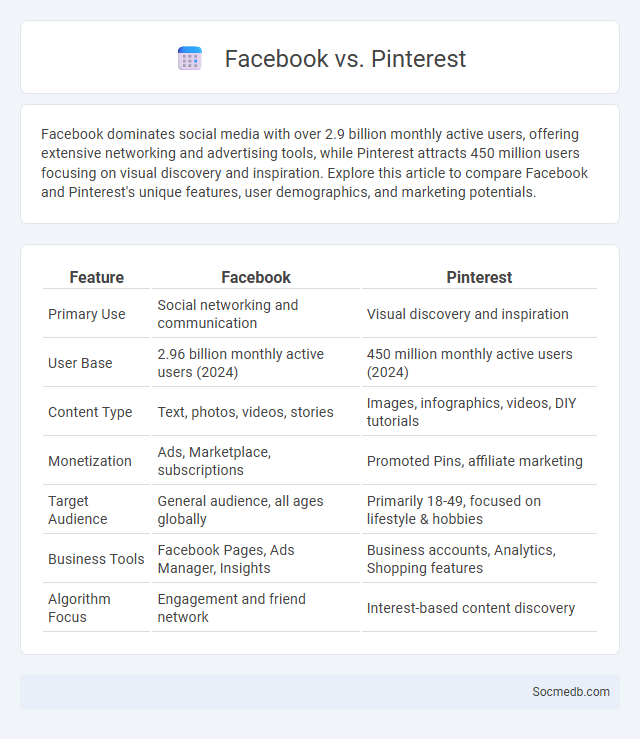
Photo illustration: Facebook vs Pinterest
Facebook dominates social media with over 2.9 billion monthly active users, offering extensive networking and advertising tools, while Pinterest attracts 450 million users focusing on visual discovery and inspiration. Explore this article to compare Facebook and Pinterest's unique features, user demographics, and marketing potentials.
Table of Comparison
| Feature | ||
|---|---|---|
| Primary Use | Social networking and communication | Visual discovery and inspiration |
| User Base | 2.96 billion monthly active users (2024) | 450 million monthly active users (2024) |
| Content Type | Text, photos, videos, stories | Images, infographics, videos, DIY tutorials |
| Monetization | Ads, Marketplace, subscriptions | Promoted Pins, affiliate marketing |
| Target Audience | General audience, all ages globally | Primarily 18-49, focused on lifestyle & hobbies |
| Business Tools | Facebook Pages, Ads Manager, Insights | Business accounts, Analytics, Shopping features |
| Algorithm Focus | Engagement and friend network | Interest-based content discovery |
Introduction to Social Media Platforms
Social media platforms such as Facebook, Instagram, Twitter, LinkedIn, and TikTok facilitate user interaction, content sharing, and community building across global audiences. These platforms offer diverse features including multimedia posting, live streaming, and targeted advertising, enabling individuals and businesses to engage effectively with specific demographics. Understanding the functionality and user base of each platform is essential for optimizing social media marketing strategies and enhancing online presence.
Overview of Facebook Features
Facebook offers a comprehensive suite of features including News Feed for real-time updates, Messenger for instant communication, and Marketplace for buying and selling items. Users can create and join Groups, host Events, and share multimedia content such as photos, videos, and live streams. Advanced privacy settings enable users to control visibility, while the platform's algorithm personalizes content based on user interactions and preferences.
Exploring Pinterest’s Unique Capabilities
Pinterest offers a distinctive visual discovery platform that enables users to curate and explore ideas through pins and boards tailored to interests such as fashion, home decor, and DIY projects. Its advanced visual search technology allows users to identify objects within images, making it a powerful tool for inspiration and product discovery. Businesses leverage Pinterest's unique ability to drive targeted traffic and engagement by showcasing visually compelling content that aligns with consumer preferences and trends.
What Are Third-Party Apps?
Third-party apps are software applications developed by external companies that connect to social media platforms to enhance user experience, offering features like scheduling posts, analytics, and content creation tools. These apps access your social media accounts through APIs, enabling seamless integration while maintaining platform security and data privacy. Understanding how third-party apps interact with your social media profiles helps you manage permissions and protect your personal information effectively.
User Demographics and Audience Reach
Understanding social media user demographics enables precise targeting of your marketing campaigns, ensuring higher engagement and conversion rates. Platforms like Facebook, Instagram, and TikTok attract varied age groups, with TikTok leading in the 16-24 segment and Facebook dominating users aged 35-54. Analyzing audience reach metrics helps optimize content distribution, maximizing visibility and impact within your specific demographic.
Content Creation and Sharing Tools
Social media platforms offer powerful content creation and sharing tools that enable you to produce engaging multimedia posts, including images, videos, and interactive stories. Features like live streaming, filters, and scheduling apps enhance your ability to reach target audiences effectively and consistently. Utilizing analytics integrated into these tools helps optimize content performance and audience engagement.
Marketing and Advertising Opportunities
Social media platforms offer unparalleled marketing and advertising opportunities through targeted campaigns that reach specific demographics based on user behavior and preferences. You can leverage data analytics and A/B testing to optimize ad performance and maximize return on investment across channels like Facebook, Instagram, and LinkedIn. These platforms also facilitate influencer partnerships and interactive content, boosting brand visibility and customer engagement in real time.
Privacy, Security, and Data Control
Social media platforms handle vast amounts of personal data, raising critical concerns about privacy and data security. Users demand stronger encryption, transparent data policies, and enhanced control over their information to prevent unauthorized access and misuse. Implementing robust security measures and user-centric data controls is essential to build trust and safeguard user privacy in digital interactions.
Integration with Business Workflows
Integrating social media platforms into business workflows enhances real-time customer engagement and streamlines marketing campaigns. Tools like Hootsuite and Salesforce Social Studio enable seamless content scheduling, monitoring, and analytics within existing CRM systems. This integration drives data-driven decision-making and boosts ROI by aligning social media activities with overall business objectives.
Choosing the Right Platform for Your Needs
Selecting the right social media platform depends on your target audience, content type, and business objectives. Platforms like Instagram and TikTok excel for visual and short-form content, while LinkedIn is ideal for professional networking and B2B marketing. Understanding where your audience spends their time helps you maximize engagement and achieve your social media goals effectively.
 socmedb.com
socmedb.com